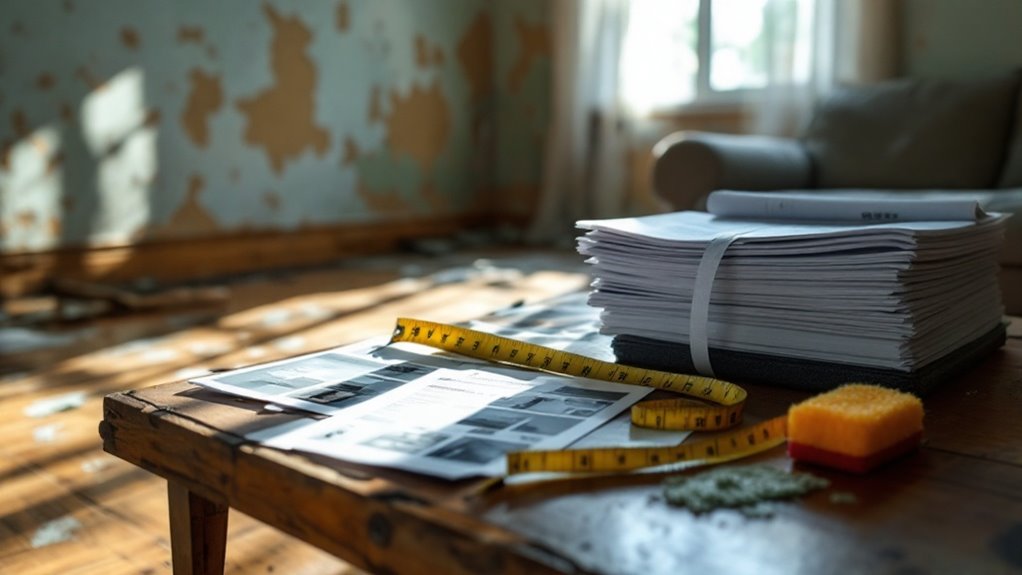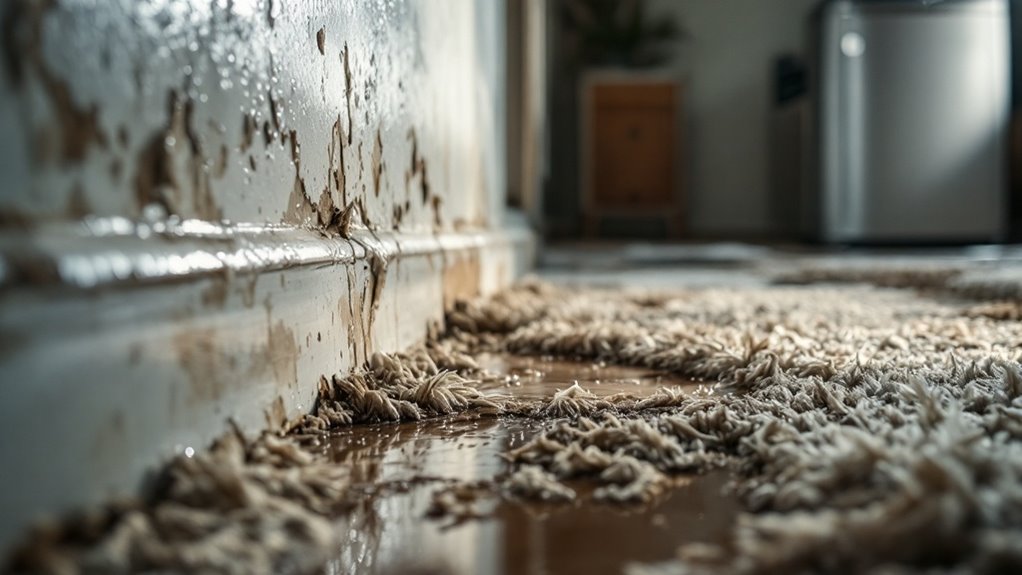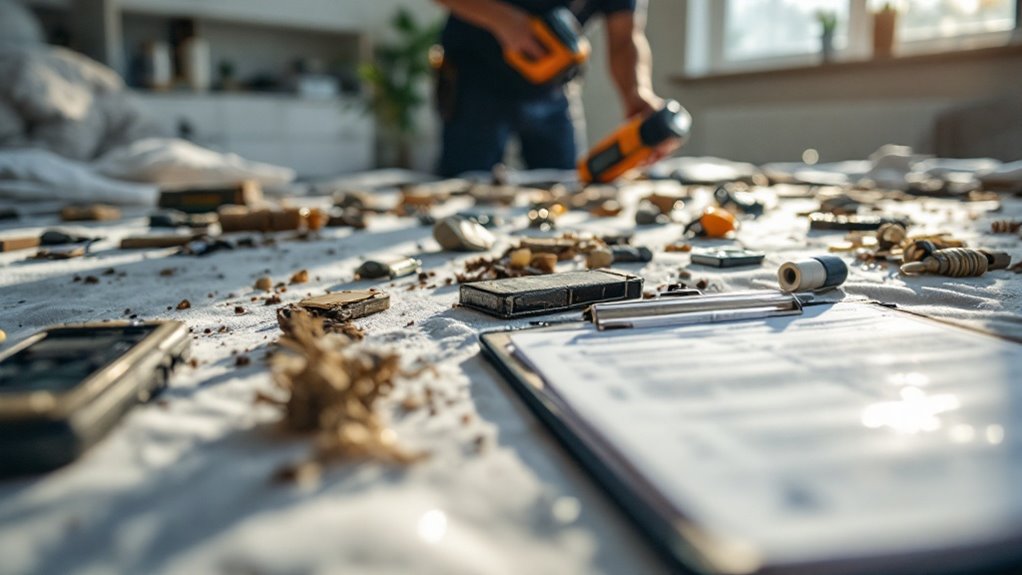In the chaotic aftermath of water damage, documentation is your lifeline, anchoring you amid the uncertainty. It’s not just about taking pictures; it’s about creating a thorough record that safeguards your interests. Without proper documentation, you might find yourself lost in a sea of claims and expenses. So, what exactly should you document to guarantee a smooth restoration process?
Key Takeaways
- Documentation provides a crucial record of damage and restoration processes, ensuring no steps are overlooked during repairs.
- It serves as essential evidence for insurance claims, demonstrating the extent of damage and restoration efforts.
- Keeping detailed records of communications with insurance companies helps clarify discussions and commitments made throughout the process.
- Photo documentation captures visual evidence of damage, providing a thorough view from multiple angles for future reference.
- Organized documentation aids in tracking restoration progress, labor costs, and materials used, facilitating smoother repairs and potential future claims.
Understanding the Importance of Documentation

When you’re dealing with water restoration, understanding the importance of documentation can’t be overstated. Proper documentation serves as an essential record of the damage and the restoration process. It helps you track what’s been done, ensuring nothing gets overlooked during repairs. Additionally, having detailed records can be critical for insurance claims, as they provide proof of the damage and the steps taken to fix it. By taking photos, keeping receipts, and noting conversations with professionals, you create a solid foundation of evidence. This not only aids in getting the compensation you deserve but also guides contractors in their work. In the chaos of restoration, clear documentation gives you peace of mind and clarity, making the entire process smoother and more manageable. Furthermore, the team consists of certified professionals who can assist in creating detailed documentation to support your claims and ensure effective restoration.
Types of Damage You Should Document
Although it might seem overwhelming, documenting the various types of damage during water restoration is essential for a successful recovery. You’ll want to capture a thorough view of the situation, including:
- Structural Damage: Cracks or warping in walls and floors.
- Mold Growth: Signs of mold on surfaces or in hidden areas.
- Water Stains: Discoloration on ceilings, walls, or floors.
- Damaged Belongings: Furniture, electronics, or personal items affected by water.
- Electrical Issues: Any exposed wiring or damaged outlets.
Additionally, thorough documentation can expedite the insurance claims process, ensuring you receive the necessary support for restoration efforts.
How to Take Effective Photos of Water Damage

When photographing water damage, use natural light to improve visibility and detail. Don’t forget to capture different angles to provide a thorough view of the damage. This approach guarantees your documentation is clear and effective for restoration purposes. Additionally, it’s essential to prepare detailed documentation of damage and restoration efforts, which can support insurance claims.
Use Natural Light
To effectively capture the extent of water damage, using natural light can greatly improve your photos. Natural light boosts visibility and reduces shadows, showcasing the damage more clearly. Here are some tips to take into account:
- Shoot during daylight hours for ideal lighting.
- Open curtains and blinds to let in as much light as possible.
- Position yourself to face the light source for better illumination.
- Avoid direct sunlight that can create glare and wash out details.
- Use a tripod to stabilize your camera and eliminate blurriness.
Capture Different Angles
Capturing different angles is crucial for documenting water damage effectively, as it provides a broad view of the affected areas. Start by taking wide shots to show the overall damage and context. Then, focus on close-ups to highlight specific issues like mold, warped flooring, or stains. Don’t forget to capture the ceiling, walls, and any affected belongings. Move around the space to find the best vantage points—this helps illustrate the damage’s extent and severity. If possible, include reference points for scale, like a ruler or a common object. Remember to take multiple shots from each angle to guarantee you have plenty of options. This thorough approach will strengthen your documentation for any insurance claims or restoration efforts.
Keeping Track of Communication With Your Insurance Company
When dealing with your insurance company, it’s vital to keep a detailed record of all communications. Jot down dates, names, and key points discussed, as this information can be important if disputes arise. Furthermore, make certain you understand your policy details to guarantee you’re fully informed about your coverage.
Document Communication History
As you navigate the complexities of water restoration, keeping a meticulous record of your communication with the insurance company is crucial. This documentation not only helps streamline the claims process but likewise serves as a reference for future discussions. Here’s what you should track:
- Dates and times of each communication
- Names and titles of representatives you spoke with
- Summary of key points discussed
- Any promises or commitments made by the insurance company
- Copies of emails, letters, or other correspondence
Note Policy Details
Understanding your insurance policy details is essential, especially during the water restoration process. You need to know what’s covered, the claim limits, and any deductibles that might apply. Keep a record of all relevant policy information, including your policy number and the contact details of your insurance agent. This way, you can quickly access the information when you communicate with your insurance company.
Whenever you discuss your claim, note down the date, time, and the name of the representative you spoke with. This creates a clear timeline and helps in case there are any disputes later. Having all this documentation on hand guarantees you’re well-prepared to navigate the claims process and receive the support you need for your water restoration efforts.
Documenting Restoration Efforts and Expenses

Documenting restoration efforts and expenses is vital, since accurate records can make a significant difference in the reimbursement process and overall project management. By keeping detailed documentation, you guarantee transparency and accountability throughout the restoration process. Here are key elements to focus on:
- Date and time of each restoration activity
- Detailed descriptions of work performed
- Invoices and receipts from contractors and suppliers
- Photographic evidence of damages and restoration progress
- Labor hours and costs associated with the project
This documentation not only helps track progress but furthermore supports your case for reimbursement. With organized records, you can quickly provide necessary information when required, making the entire process smoother and more efficient.
The Role of Documentation in Insurance Claims
Accurate documentation not only streamlines project management but also plays a pivotal role when filing insurance claims. When you encounter water damage, documenting every step of the restoration process guarantees you have the necessary evidence to support your claim. This includes taking photos, keeping receipts, and noting the actions taken during the restoration. Insurers often require detailed records to validate your losses and expenses. By maintaining thorough documentation, you strengthen your case for coverage, making it easier for adjusters to review and approve your claim. Inconsistencies or missing information can lead to delays or denials, so don’t underestimate the importance of being organized and precise. Your efforts in documentation can greatly impact your insurance outcome.
Legal Considerations in Water Damage Documentation
How can you guarantee your documentation stands up to legal scrutiny during a water damage restoration? To ascertain your records hold up, focus on these key elements:
- Detailed descriptions: Document each step of the restoration process.
- Photographic evidence: Take clear, timestamped photos of damage and repairs.
- Inventory lists: Keep track of damaged items and their values.
- Professional reports: Include assessments from certified professionals.
- Communication logs: Record all interactions with contractors, insurance agents, and other involved parties.
Benefits of Organized Documentation for Future Reference
While you may not think about it at the time, organized documentation during water restoration can be invaluable for future reference. Having clear records allows you to track the progress of the restoration, ensuring nothing gets overlooked. It additionally helps you remember what materials were used, which can be vital for future repairs or insurance claims. When you face a similar issue later, you’ll have a detailed blueprint to guide you. Organized documentation can likewise serve as proof of the work done, providing reassurance to insurers or potential buyers. Plus, it can help you identify patterns or recurring problems, allowing you to take proactive measures. In short, it’s the foundation for educated choices down the road.
Tips for Creating a Comprehensive Water Damage Record
To create an extensive water damage record, start by gathering all relevant information right from the beginning. This documentation will help you track the damage and support any claims you may need to file. Here are some tips to guarantee you capture everything:
- Take photos: Document the damage visually from multiple angles.
- Keep notes: Write down dates, times, and descriptions of the damage.
- Record conversations: Jot down details from discussions with contractors or insurance agents.
- Save receipts: Keep all invoices and bills related to repairs and restoration.
- List affected items: Create an inventory of damaged belongings for insurance purposes.
Conclusion
To summarize, thorough documentation during water restoration isn’t just a bureaucratic chore; it’s a critical step in protecting your investment and ensuring a smooth recovery. By capturing every detail, you not only ease the insurance process but additionally create a valuable resource for future reference. Isn’t it worth the effort to have peace of mind and a clear record of your property’s journey back to normalcy? Don’t underestimate the power of well-organized documentation.
